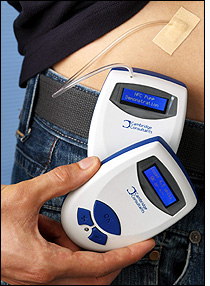Aug 25, 2006RFID may soon help diabetics better control the level of sugar in their blood. Technology developer Cambridge Consultants, in collaboration with Philips Semiconductors, has built a prototype medical device consisting of a glucometer and an insulin pump. The two are wirelessly linked together using near-field communications (NFC).
NFC is an RFID-based wireless communications standard that allows the transmission of data at a frequency of 13.56 MHz between devices situated within 10 centimeters of each other. This technology combines the functions of a contactless reader, a contactless card and peer-to-peer functionality on a single chip.
When using the prototype RFID device, a patient pricks his skin with a lancet or needle, places a drop of blood on a test strip and inserts the strip into a glucometer, a small portable machine used to check the glucose level of the blood. The glucometer records the blood-sugar reading, and if it indicates a higher-than-normal glucose concentration, the device will then recommend a bolus dose of insulin. (A bolus dose is an extra amount of insulin taken to cover an expected rise in blood glucose, often related to a meal or snack.)
If the patient decides to accept the dose, he passes the glucometer—which contains an NFC-based chip and antenna—near the insulin pump (also embedded with an NFC-based chip and antenna). The recommended dosage data is wirelessly passed to the insulin pump, which delivers the drug via a subcutaneous catheter, as per the recommendation.
"The key benefit of NFC in the application is a feature we call 'patient-in-the-loop,'" says Paul Williamson, business-development consultant with Cambridge Consultants. Based in Cambridge, England, the company also has headquarters in Boston. Because it allows the patient to decide whether to take the bolus dose or not, he says, "this feature gives patients the confidence and control over their treatment."
Williamson acknowledges that the NFC-enabled glucometer and pump isn't for everybody, but says it may offer an alternative to current devices. Currently, diabetics either use glucometers and administer doses when necessary via injections, or utilize insulin pumps that constantly monitor glucose levels and automatically deliver insulin as needed (a closed-loop feature).
Cambridge Consultants is now demonstrating the prototype to companies that are primarily market devices for diabetes treatment. But the prototype will also be used to highlight how NFC can be utilized in other types of medical devices to provide pain relief, asthma and respiratory care, gastric electrical stimulation therapy and treatments for congestive heart failure or urinary urge incontinence. "We'll use the prototype as part of the portfolio we present to medical device companies looking for ways to improve their products," Williamson says.
NFC technology is already being tested in non-medical applications, including applications for mobile payments (see JCB to Run RFID Payment Trial in Amsterdam) and cell phones that can serve as keys to unlock doors (see NFC-enabled Phones to Unlock Hotel Rooms).


